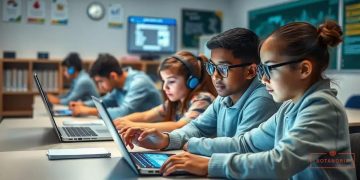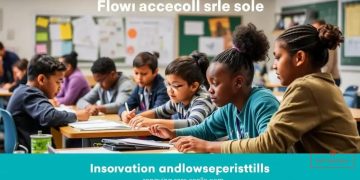AR/VR in classrooms: transforming learning experiences
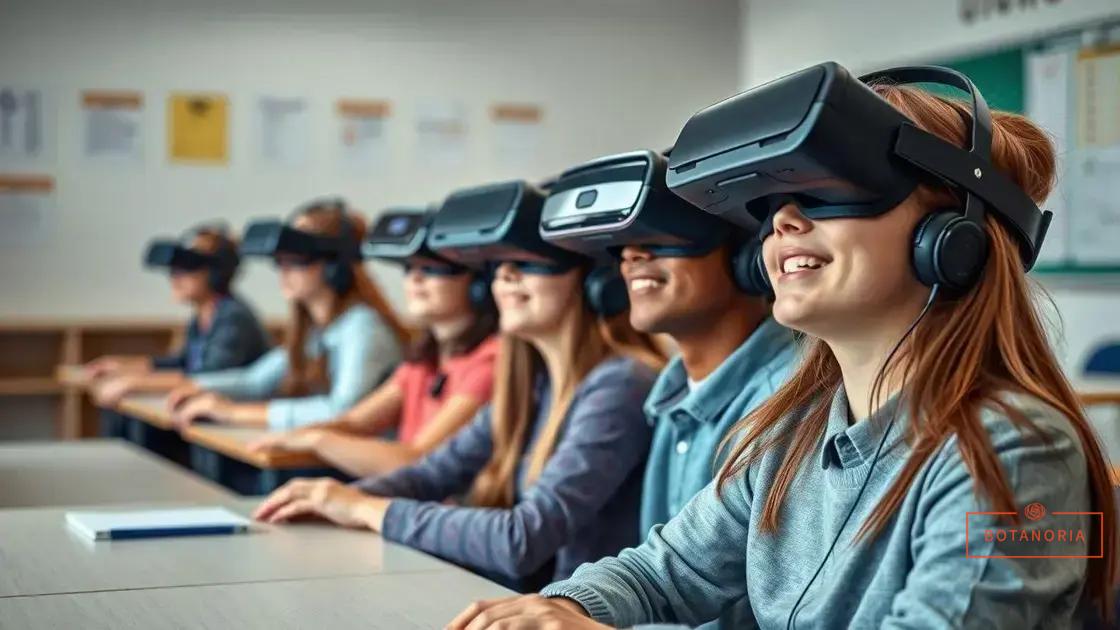
AR/VR in classrooms enhances student engagement and understanding by providing immersive, interactive learning experiences that cater to diverse learning styles while facing challenges like technical limitations and the need for adequate training.
AR/VR in classrooms is changing how students learn and interact with the material. Imagine walking through ancient Rome or exploring the human body—all from your desk! This technology offers exciting possibilities for enhancing education.
Understanding AR and VR technologies
Understanding AR and VR technologies is essential for grasping their impact on educational environments. Augmented Reality, or AR, enhances our perception of the real world by overlaying digital information onto it. In contrast, Virtual Reality, or VR, immerses users in a completely virtual environment. Both technologies offer unique opportunities for learning.
The Basics of Augmented Reality
AR can create interactive experiences by using devices like smartphones or AR glasses. As students point their devices at objects or images, they can see additional content, such as videos or 3D models. This method can make lessons more engaging, bringing subjects like history or science to life.
The Power of Virtual Reality
Unlike AR, VR requires a headset to fully transport users into a different world. Here, students can explore ancient ruins or take a journey through the solar system. This full immersion helps deepen understanding through sensory experiences.
- Enhances spatial awareness.
- Encourages active participation.
- Accessible experiences for all learners.
Both AR and VR engage multiple senses, which can drive motivation in students. When learners can visually and physically interact with content, they are more likely to retain information. Furthermore, these technologies cater to different learning styles, making them beneficial for diverse classrooms.
As educational institutions adopt these tools, teachers can personalize learning experiences. For instance, students can work on projects that involve AR applications to create presentations or explore simulations in VR that relate to their studies. This transformation leads to deeper inquiry and creativity.
In summary, understanding AR and VR technologies opens doors to innovative educational experiences. By leveraging their unique capabilities, educators can create engaging and effective learning environments that resonate with today’s tech-savvy students.
Benefits of AR/VR in classroom settings
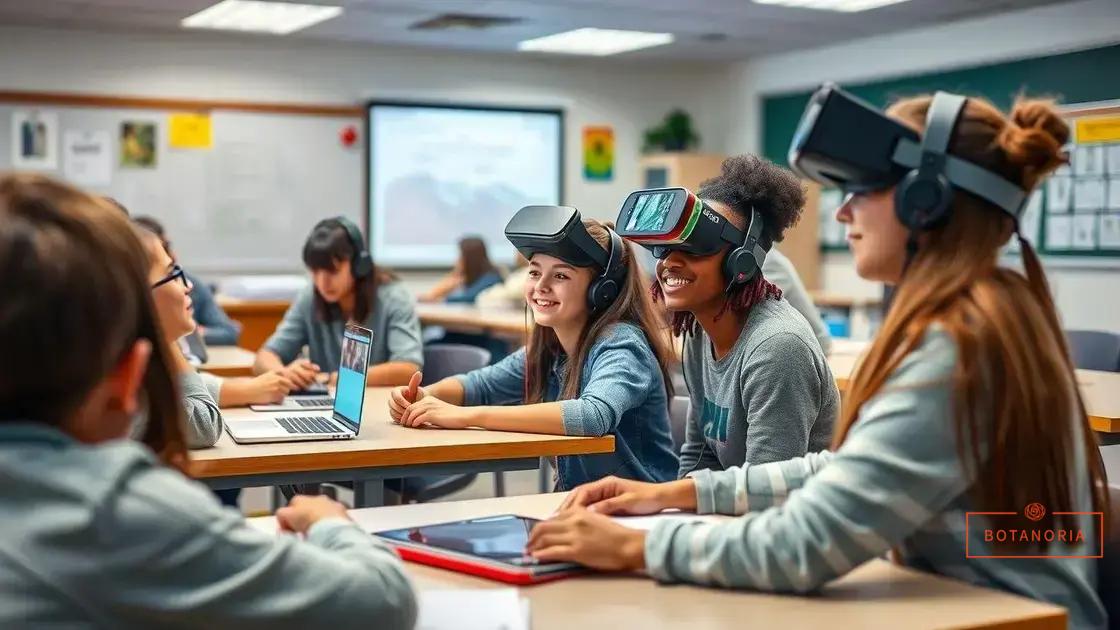
The benefits of AR and VR in classroom settings are transformative and exciting. These technologies not only make learning more engaging but also enhance understanding through interactive experiences. With the power of AR and VR, students can visualize complex concepts, making abstract ideas more concrete.
Enhanced Engagement
One of the primary advantages of AR and VR is the ability to captivate students’ attention. When learners interact with dynamic content, they are more likely to participate actively in lessons. This engagement leads to higher retention rates and a deeper understanding of the material.
Increased Accessibility
Another significant benefit is that these technologies can make education more accessible. For instance, students with disabilities can experience lessons in a way that suits their individual needs. The immersive nature of VR provides opportunities for all students to learn at their own pace, ensuring inclusivity.
- Interactive simulations bring real-world scenarios into the classroom.
- Students can explore historical events or scientific processes through virtual experiences.
- Teachers can use these tools to create personalized learning paths for each student.
Moreover, AR and VR foster collaboration among students. They can work together on projects, interacting with the same 3D models or virtual environments. This teamwork encourages communication and problem-solving skills, vital for their future careers.
Additionally, incorporating AR and VR in lessons can spark greater curiosity and creativity. By experimenting with hands-on experiences, students can pursue their interests more deeply. This freedom leads to innovative thinking and fuels a passion for learning.
As educational institutions embrace these technologies, we will likely see improved academic performance. The combination of interactive learning and personalized experiences caters to the diverse needs of students, making education more effective and enjoyable.
Implementing AR/VR solutions in education
Implementing AR and VR solutions in education can be exciting and rewarding. Schools increasingly recognize the potential of these technologies to create immersive learning experiences that capture students’ attention and enhance their understanding of complex subjects. By carefully integrating these solutions, educators can make their classrooms more interactive.
Identifying the Right Tools
Choosing the right AR and VR tools is the first step in successful implementation. Many platforms offer a range of applications designed for educational purposes. For instance, some tools allow students to explore the human body in 3D or visualize historical events.
Training Educators
To make the most of these technologies, it’s crucial to train teachers on how to use them effectively. Professional development workshops can help educators understand the capabilities of AR and VR tools and how to incorporate them into their lesson plans. This training ensures that teachers feel confident in using these tools to engage students.
- Provide hands-on training sessions for teachers.
- Share best practices and successful case studies.
- Encourage collaboration among staff to develop AR/VR activities.
After training, schools can start integrating AR and VR into existing curricula. For example, science classes can benefit from virtual chemistry labs that allow students to experiment without physical limitations. This process can foster creativity and exploration in ways that traditional methods cannot.
Furthermore, collaborating with technology providers can smooth the implementation process. Many companies offer support in setting up devices and developing custom applications for specific educational needs. This partnership paves the way for smoother integration and ongoing support.
As schools begin to utilize AR and VR, they should also seek feedback from students to discover what works best. Engaging students in discussions about their experiences with these technologies can provide valuable insights and help fine-tune their educational offerings. Continuous improvement will make lessons even more effective and enjoyable.
Challenges faced when using AR/VR
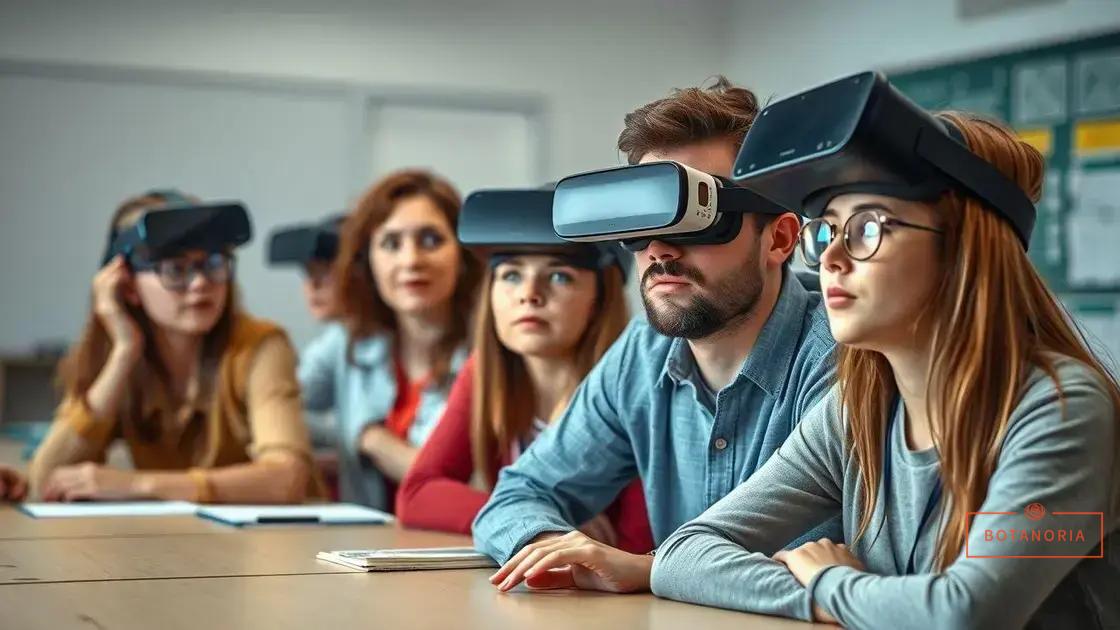
Despite the many advantages of AR and VR in education, there are several challenges that educators and institutions face when implementing these technologies. Understanding these obstacles is key to overcoming them and maximizing the benefits.
Technical Limitations
One significant challenge is the technical limitations of AR and VR tools. Not all schools have access to advanced hardware or software needed for effective implementation. Some devices can be expensive, and budget constraints may prevent schools from acquiring necessary technology.
Learning Curve
Additionally, there is often a learning curve associated with these technologies. Teachers must become comfortable using AR and VR tools. Without proper training, educators might struggle to utilize these technologies effectively, which can hinder student engagement.
- Teachers need ongoing support to navigate technical challenges.
- Students may initially find it difficult to adapt to new learning methods.
- Classroom management can become complicated with new tools.
Moreover, not all students respond positively to AR and VR experiences. Some learners may feel overwhelmed by the immersive nature of VR, while others might struggle with distractions in AR environments. Educators must address these varying responses to create an inclusive learning atmosphere.
Compatibility issues can also arise. Different devices may not work well together, which can lead to frustrations during lessons. Teachers might have to spend additional time ensuring that all students can access the same content, which can disrupt the flow of classes.
Finally, there’s the challenge of creating a curriculum that effectively integrates AR and VR. It requires thoughtful planning and collaboration among educators to align these technologies with learning objectives. As these tools continue to evolve, keeping up with trends and updates can be demanding.
Future trends in AR/VR education
Future trends in AR and VR education are paving the way for innovative learning experiences. As technology continues to evolve, these tools are becoming more accessible and affordable for schools. Educators are looking for new ways to integrate these immersive technologies into their classrooms.
Increased Accessibility
One major trend is the push for increased accessibility to AR and VR tools. As hardware becomes more affordable, more schools can invest in these technologies. This shift allows a wider range of students to experience interactive learning without significant barriers.
Enhanced Personalization
Another trend is the move towards personalized learning experiences. AR and VR can tailor educational content to meet the needs of individual students. For example, learners can progress at their own pace and choose experiences that match their interests and learning styles.
- Adaptive learning technologies will help customize lessons.
- Students can explore subjects that fascinate them through immersive content.
- Educators can track progress and adjust materials accordingly.
Furthermore, collaboration between teachers and technology developers is on the rise. This partnership will lead to the creation of more polished and effective educational applications. By working together, educators can provide feedback that improves the design and functionality of AR and VR tools.
Additionally, the incorporation of artificial intelligence into these technologies is expected to enhance their capabilities. AI can analyze how students interact with AR and VR content, providing insights into their learning patterns. This data can help teachers make informed decisions about how to support their students more effectively.
Finally, we are likely to see an expansion in the types of content available. As more educational institutions create their own AR and VR experiences, the variety will increase. Students will soon have access to virtual trips, historical simulations, and science experiments that bring learning to life.
FAQ – Frequently Asked Questions about AR/VR in Classrooms
How can AR/VR improve student engagement?
AR/VR provides immersive experiences that capture students’ attention and make learning more interactive and enjoyable.
What are the main challenges of implementing AR/VR in education?
Challenges include technical limitations, training needs for educators, and ensuring accessibility for all students.
What future trends can we expect in AR/VR education?
Future trends include increased personalization, improved accessibility, and the integration of artificial intelligence in AR/VR tools.
How can teachers effectively use AR/VR in their classrooms?
Teachers should undergo training, collaborate with tech providers, and create lesson plans that incorporate AR/VR to enhance learning objectives.


